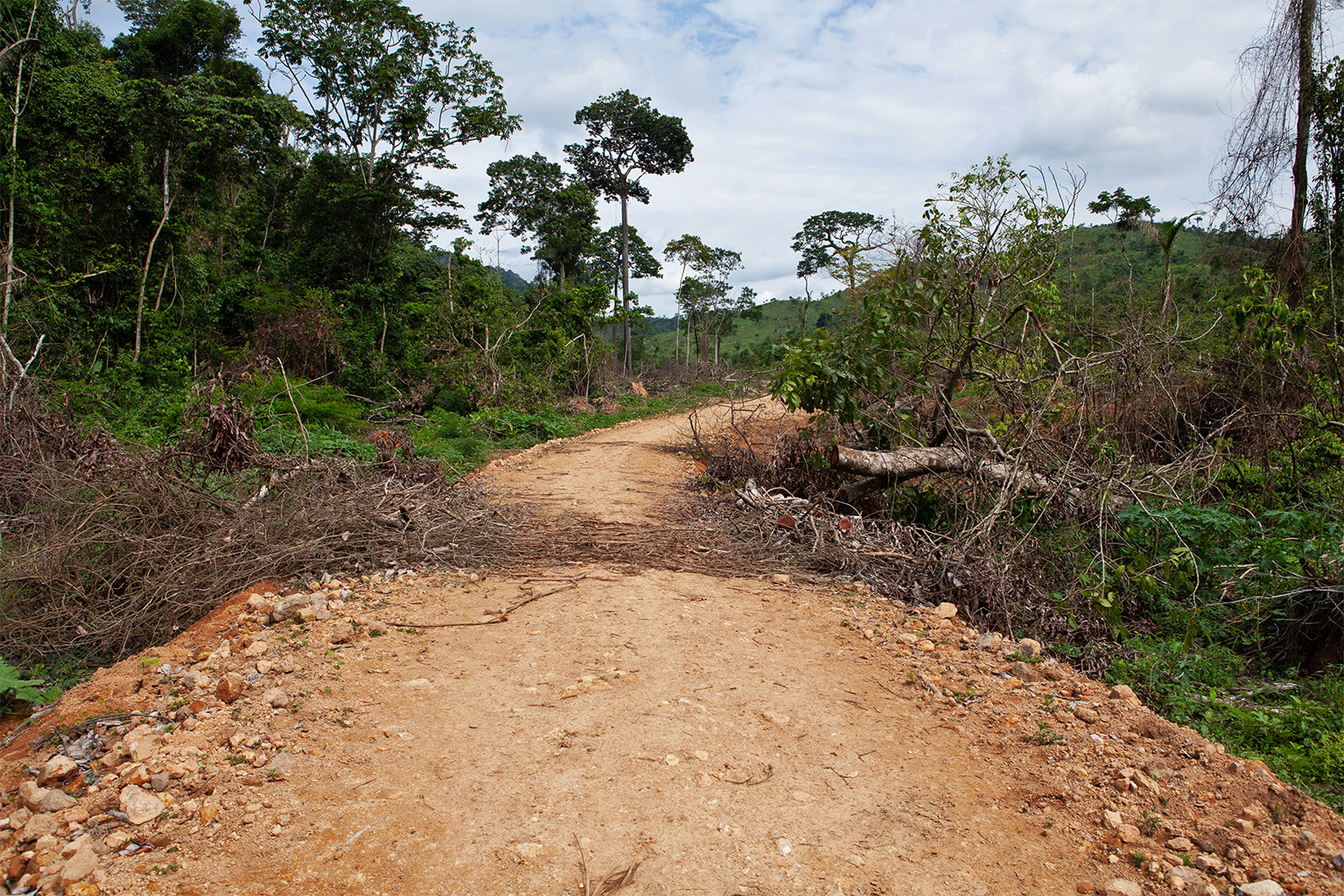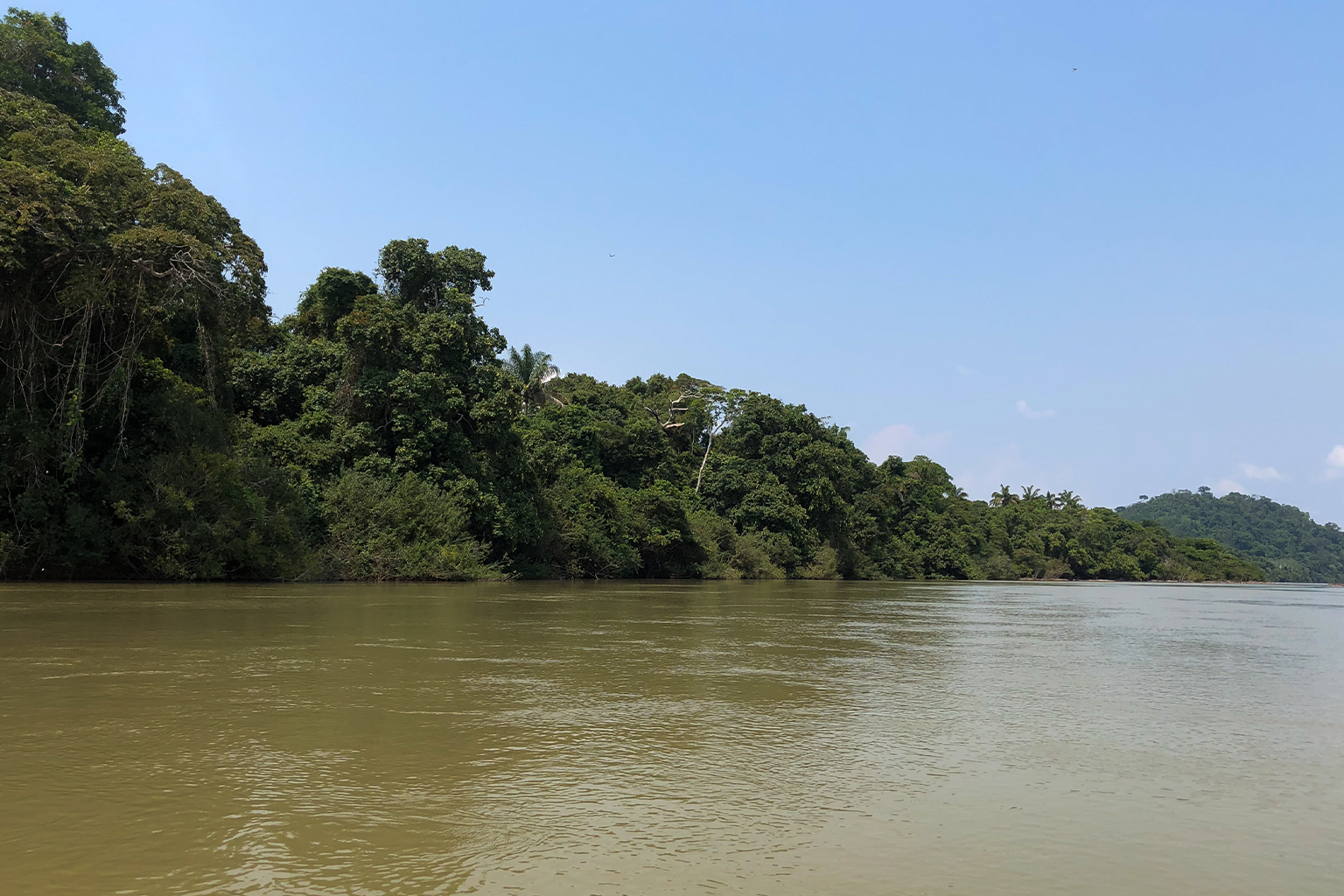- Terra do Meio Ecological Station, a pristine reserve under federal protection, has suffered invasions amid efforts to open up an illegal road cutting through the rainforest.
- Much of the deforestation is spilling over from APA Triunfo do Xingu, a sustainable use reserve that has become one of the most deforested corners of the Amazon in recent years.
- Federal and state authorities have cracked down on environmental crime in the region, but experts say this has not been enough to halt the advance of the road or stop outsiders from turning forest into pasture.
- Environmentalists worry that, if invaders succeed in fully opening up the road, it would splinter an important ecological corridor meant to protect the region’s rich biodiversity and its Indigenous residents.
The makeshift road tears through the emerald canopy, splintering one of the Amazon’s most pristine corridors of rainforest. Along the edges of the road, running through the heart of the Terra do Meio Ecological Station, swaths of jungle have been razed and turned into pasture.
Under federal protection since 2005, Terra do Meio spans 3.37 million hectares (8.33 million acres) across the municipalities of Altamira and São Félix do Xingu, strongholds of Brazilian cattle ranching. Tucked deep into the Xingu Basin, it’s part of an ecological mosaic of 28 conservation areas and 21 Indigenous territories that together form a tapestry of forest treasured for its rich biodiversity.
Although virtually all human activity is barred within Terra do Meio, the reserve has been battered by invasions in recent years, losing 15,740 hectares (39,000 acres) of primary rainforest between 2019 and 2022, according to data from the University of Maryland visualized on Global Forest Watch.

And, despite a sharp drop in overall deforestation across the Amazon this year, the incursions into Terra do Meio have not let up: satellites detected 171,259 high-confidence deforestation alerts between Jan. 6 and Nov. 20 within the protected reserve, the data show.
Environmentalists largely blame the devastation within Terra do Meio on pressure from invaders bent on opening up a strategic transport route slicing through the rainforest. They say this risks creating a dangerous new route for illegal timber, gold and – eventually – soy or beef destined for export.
“It’s this relentless effort to open up this road,” said Ane Alencar, science director at the Amazon Environmental Research Institute (IPAM). “And it’s placing huge pressure on the reserve.”
The clandestine road stretches 43 kilometers, starting in the Área de Proteção Ambiental (APA) Triunfo do Xingu and running through Terra do Meio before entering into the Iriri State Forest, according to analysis by Rede Xingu+, a network of nonprofits monitoring deforestation in the Xingu Basin. There, it halts near another illegal road leading to a clandestine gold mine deep in the rainforest.

In May, authorities created a barrier at the main entry of the Terra do Meio reserve in a bid to halt the invasions, a spokesperson for Brazil’s environmental ministry said. Environmental police also carried out a series of operations in the region earlier this year, handing out R$ 18.9 million ($3.9 million USD) in fines between April and July, placing 2,000 hectares (4,942 acres) under embargo, and identifying those responsible for the construction of the illegal road within Terra do Meio.
But experts worry about a persistent push to open up a final stretch of this clandestine route linking São Félix do Xingu and Novo Progresso, two hubs of deforestation. Environmental advocates fear this would open the floodgates to destruction in one of the Amazon’s most ecologically rich areas.
“The impact would be enormous,” said Ane Alencar, science director at IPAM. “The consolidation of this route would be an attack on the heart of Terra do Meio.”
Advancing deforestation
The forest around the Xingu Basin has been vanishing for decades – first as newcomers flooded in from other states in search of land they could call their own and, later, as they scrambled to expand their agricultural holdings.
Terra do Meio, along with much of the Xingu mosaic, was created in the early 2000s to protect the region’s dwindling forests from the rapid advance of cattle ranching. The corridor was also supposed to offset the environmental and social damage of mega projects like the paving of the BR-163 highway and the Belo Monte hydroelectric dam.
“The idea was to shield the Xingu and the Indigenous peoples who live here,” said Ivar Busatto, general coordinator of OPAN, a nonprofit focused on Indigenous rights. “Because they were being circled by these development projects.”

But critics say the mosaic is failing to stop incursions into Terra do Meio, with much of the deforestation spilling over from neighboring APA Triunfo do Xingu, a sustainable development reserve tucked in the heart of Brazil’s largest cattle ranching municipality, home to nearly 20 times more livestock than people.
In recent years, APA Triunfo do Xingu, once intended as a buffer for ecologically important areas like Terra do Meio and Iriri State Forest, has become one of the most deforested slices of the Brazilian Amazon. Since 2006, it has lost about a third of its forest cover.
“Today, there is no buffer,” said an environmental advocacy source who works in the region and asked to remain anonymous. “What we see are huge areas being deforested and burned right on the doorstep of other protected areas, at this absurd proximity.”
Satellite imagery from Google Timelapse shows how deforestation has progressed in APA Triunfo do Xingu.
The impact has been clear: deep in Terra do Meio, rectangular patches of forest have been replaced by cattle pasture as the clandestine road has opened up access deeper into the territory, experts say.
In recent years, swaths of the reserve have also been engulfed by devastating fires started next door. Cattle ranchers routinely use slash-and-burn farming techniques to renew degraded pastures, while speculators seeking to expand their landholdings set fires to finish clearing freshly deforested areas. Fed by parched forest, the flames can often spread quickly far beyond the intended area.
More recently, Pará has tried to push forward a greener agenda that envisions a different economic model for the region. The state, which is poised to host the UN Climate Summit in 2025, plans to auction off concessions to 4.2 million hectares of public lands, including APA Triunfo do Xingu, to those interested in restoring or preserving these areas. Those who purchase the rights to manage these forests would be granted carbon credits.
“From the bioeconomy we can build a new economic scenario,” governor Helder Barbalho said at a conference in London earlier this year. “These are new opportunities that will generate green jobs and demonstrate that it is possible to reconcile development and sustainability.”
Still, in this corner of the Amazon, agriculture remains a formidable force. A decade-old plan to build a 1,000-kilometer railway connecting Sinop in Mato Grosso to Itaituba, a port town in Pará, remains the region’s most important project for economic growth. The railroad has drawn criticism from environmentalists, who oppose plans to shrink an important national forest to make construction possible, and was suspended temporarily by the Supreme Court last month.

Notably, the illegal road being carved into Terra do Meio would link São Félix do Xingu to important routes for the transport of agricultural products, including BR-163 and the future railway.
“Just talking about building this railroad has set off a rise in deforestation in this region,” the advocacy source said. “It’s a speculative rush to grab land.”
Turning a new leaf
Across the Amazon, forest destruction slowed dramatically this year under the leadership of President Luiz Inácio Lula da Silva, who promised to crack down on deforestation and expel illegal miners, loggers and ranchers from protected areas.
Since taking office in January, Lula has scrambled to undo the policies of his predecessor, Jair Bolsonaro, who encouraged development within protected reserves, halted the demarcation of Indigenous lands and gutted environmental enforcement agencies of staff and resources.
Now, federal agencies like Ibama and ICMBio have once again cracked down on environmental crimes in the Amazon, embargoing thousands of hectares of land and handing out millions in fines. Authorities have also expelled thousands of illegal squatters from Indigenous territories like Yanomami and Apyterewa.
Since January, the government has also been fighting environmental crimes in Terra do Meio, the environmental ministry spokesperson said. “Invasions have increased in the last four years, with a drop in inspections, incentives for mining and livestock farming within protected areas.”
And so far, these actions appear to be having a tangible effect on environmental destruction. The Brazilian Amazon saw deforestation fall 61% between January and October, compared to the same period last year, according to data from nonprofit research institute Imazon. This marked the lowest rate of deforestation since 2018.
“We’ve seen a significant impact from more policing and more engagement from government organs,” said Márcio Santilli, co-founder of the Instituto Socioambiental, a nonprofit that defends environmental diversity. “And this certainly gives fresh force to Lula’s government.”

Yet, halting forest clearing in many slices of the Amazon has proven difficult. Some 3,806 square kilometers of forest were cleared in the first ten months of this year, or roughly 1,200 soccer pitches per day, the Imazon figures show.
The challenges have been especially clear in Pará, which slashed forest clearing by two-thirds this year but still leads the ranking as Brazil’s most deforested state, accounting for 31% of the country’s destruction. Seven out of the 10 municipalities with the highest rate of deforestation are located within the state.
“They [authorities] have limited resources, so they have to make choices,” Santilli said. “It’s impossible to attack on all fronts, everywhere at the same time.”
In a bid to halt the destruction, state authorities have installed permanent bases tasked with combating environmental crime in several regions, including São Felix do Xingu. The state has also launched a high-powered operation dubbed “Curupira,” which has expelled and fined illegal loggers, miners, lang-grabbers and ranchers from public forests and protected lands.
Still, this has not been able to fully halt the advance into Terra do Meio, according to Alencar, who said local, state and federal authorities must join forces in order to truly put an end to incursions into the reserve.
“The state has put in place supervision and enforcement. But it hasn’t been enough to really stop this movement.”
Banner Image by Rhett A. Butler/Mongabay.
Editor’s Note: This story is powered by Places to Watch, a Global Forest Watch (GFW) initiative designed to quickly identify concerning forest loss around the world and catalyze further investigation of these areas. Places to Watch draws on a combination of near-real-time deforestation alerts, automated algorithms and field intelligence to identify new areas on a monthly basis. In partnership with Mongabay, GFW is supporting data-driven journalism by providing data and maps generated by Places to Watch. Mongabay maintains complete editorial independence over the stories reported using this data. Sign up for GFW’s monthly email updates featuring these stories.
Feedback: Use this form to send a message to the editor of this post. If you want to post a public comment, you can do that at the bottom of the page
